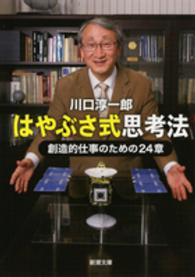- ホーム
- > 洋書
- > 英文書
- > Juvenile Grades 7-9
Full Description
This book is written to meet the requirements of the 2001 GCSE PE specifications for all awarding bodies. New features link the application of PE theory to practical work and sports performance. An integrated approach develops knowledge and understanding and improves revision techniques. This book enhances understanding and confidence by reinforcing the information with clear and attractive diagrams, tables and photographs.
Contents
Part 1 Our body systems: our nervous system; our skeletal system; our muscular system; our circulatory system; our respiratory system; our hormonal system; our digestive system. Part 2 Energy in action: creatine phosphate system; lactic acid system; aerobic system; energy systems and sport; training our energy systems. Part 3 Fitness for health and performance: what is health-related fitness?; what is sport-related fitness?; what is stamina (or aerobic capacity)?; what is flexiblity?; what is body build?; what is strength?; what is muscular power?; what is muscular endurance?; what is speed?; what is agility?; what is coordination?; what is balance?; what is reaction time?. Part 4 Training for success: principles of training; training methods; how do we plan our training programme?; how do we design a training programme?; age and training; gender differences and training; long-terms effects of training. Part 5 Skill in sport: what is skill?; how do we learn skills?; how do we perform skills?; how do we analyze our performance?; how do we improve our performance?. Part 6 Care of our bodies: sensible eating; food for sport; social drugs; performance-enhancing drugs; social drugs and sport; performance-enhancing drugs and sport; the right lifestyle. Part 7 Safety in sport: planning for safety; reducing risk; causes of sport injuries; soft- and hard-tissue injuries; emergency procedures; dealing with extreme conditions. Part 8 The changing face of sport: developments in British sport; the changing Olympics; the role of the performer; new technology. Part 9 Providing for sport: which organizations provide for sport?; who controls international sport?; who provides sports facilities?; funding for sport - an overview; who provides the money for sport?. Part 10 Taking part in sport: leisure time; benefits; home influences; school influences; school and community links; national campaigns; gender and sport; black and ethnic minorities and sport; disability and sport; older people and sport; careers in sport. Part 11 Sport as a spectacle: sponsorship; the media; television; sport, sponsorship and television - the future?.








